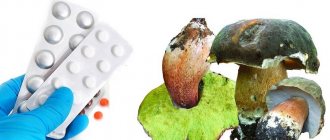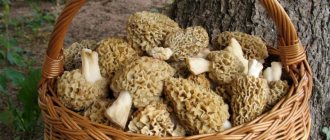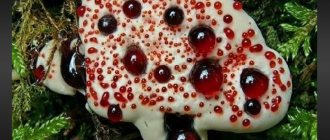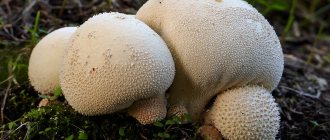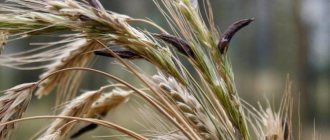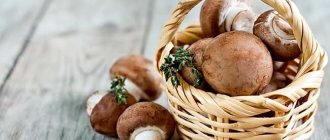Mushroom pickers often collect conditionally edible mushrooms along with edible ones. Their main difference is that such fruiting bodies can be consumed only after preliminary thorough heat treatment. Some species in this group are suitable for canning. Their taste is often not inferior to popular edible species.
Conditionally edible mushrooms
Where are conditionally edible mushrooms used?
Semi-edible mushrooms are usually rich in beneficial substances, so they are used for medicinal purposes. Modern medicine and pharmaceuticals extract many healing properties from these mushrooms that can affect the outcome of a serious illness.
Semi-edible mushrooms are widely used in medicine to treat various diseases. Not all healthy components have been studied, but those that are known are effectively used for the prevention and treatment of diseases, in dietetics and cosmetology.
Contraindications
In general, milk mushrooms are not harmful and have virtually no contraindications, but they can have a detrimental effect on humans if they are not prepared correctly.
In addition, harm can be caused to the body if a large amount of such a product is consumed, especially if there are stomach problems. After all, all mushrooms, especially nigella, are difficult for the stomach.
To take or not to take
The main part of semi-edible mushrooms has a pleasant taste and nutritional qualities. The most important thing is to correctly identify them and prepare them accordingly. If a mushroom picker makes a mistake by confusing a conditionally edible mushroom with an inedible one, or does not subject it to proper culinary processing, the matter may result in health problems, even death.
It is important to know and follow the rules for preparing semi-edible mushrooms
Fifth place - raincoat
Mushroom - puffball
This mushroom is also called grandfather's tobacco, because during the ripening process a cavity with grayish or brownish spores is formed inside its pulp. When the fruiting body is fully ripe, it will be a whitish ball with a thin skin, filled with these spores. This mushroom should be collected before this process is completed, while the flesh is still white. It is recommended to soak it for 1-2 hours, or boil it for 10 minutes before further cooking.
Interesting: The most poisonous mushrooms in Russia - list, name, description, photo and video
Tubular conditionally edible mushrooms
Tubular, conditionally edible mushrooms have strong caps and look attractive. But they still need to be distinguished from their completely edible counterparts.
Wolf boletus
The semicircular boletus cap has red-pink dry skin. Its diameter reaches 5-10 cm. The short yellow leg thickens towards the middle and turns blue when pressed. The pulp is light yellow, tender. The taste and smell do not stand out at all. These mushrooms grow in clusters in northern Israel. They can be found from November to January.
Wolf's boletus is a large and beautiful mushroom growing in the northern regions of Israel.
Poddubovik
The first boletus mushrooms appear in June, but the period of rapid growth begins in August and continues until November. It grows in oak groves, but it can also be found next to birch, linden, and beech trees.
This mushroom can be confused with the poisonous satanic mushroom. The main difference: the underburden turns blue at the site of the cut, then darkens, the satanic one turns red and eventually becomes light.
There are two types of butterfly: ordinary (olive-brown) and speckled.
Podubovik usually grows in oak forests and other deciduous forests
Common dubovik
It has a massive yellowish leg with a thin brownish mesh and a semicircular cap of light olive-brown color.
Speckled oakweed
Reddish scales are scattered along the thick yellow stem. The cap is dry and velvety, has a dark brown color.
Common and speckled oakweed
Ruby oiler
The hemispherical cap is yellow-brown or brick-red. The massive cylindrical leg is painted pinkish. Under the cap there is a red tubular layer. Yellow pulp, colorless and odorless. Grows in oak groves. Rarely seen.
Ruby oiler is a rare Red Book species, found on decaying oak wood
Goat oiler
It has a slimy and sticky light brown cap and the same stem. The tubular layer is rusty. The pulp is yellowish. About half of the mushrooms found turn out to be wormy. Found in temperate climates in spruce and pine forests. It grows after heavy rains.
Loves sandy soil. Found from July to September.
Goat oiler and Siberian oiler
Siberian oiler
The slimy yellowish cap is overgrown with brown fibers and reaches 4-10 cm in diameter. The thin brown leg is 1-1.5 cm thick. The flesh is yellow. Grows in Siberia and the Far East in coniferous forests. Settles in large groups under cedar trees. Found between August and September.
Fir oiler
The dirty yellow cap, reaching 4 cm in diameter, is covered with brown scales, condensing towards the center. A thin curved stalk, reaching 4 cm in diameter, is covered with conical warts. The olive-yellow or orange-yellow tubes are arranged in radial rows.
The fir oil can has a wide convex cap with an uneven edge, painted dirty yellow.
Grows under fir trees in mixed and cedar-fir forests. The growth period is from July to September.
Oiler gray
The cap is cushion-shaped and light gray with a green or purple tint. It reaches 10 cm in diameter. The dense stem with a white felt ring reaches 8 cm in height. The tubular layer is grayish-white. The pulp is white and watery, turning blue at the break. Gray oiler grows in clusters in pine and larch forests.
Gray oiler - a small tubular mushroom with a smooth, hemispherical cap
Red-spore porphyry
It has a matte brown cap with an indefinite cushion shape and red-brown spores. The diameter of the cap reaches 5-9 cm, the length of the stem is 10-12 cm. On damp soil, mushrooms grow with elongated stems, on dry soil - with short ones. The pink-yellow tubes turn blue-green when pressed.
Belongs to rare species listed in the Red Book. Rich in carbohydrates and proteins.
Red-spored porphyry and false birch
Porphyry false birch
A cushion-shaped cap with a diameter of 4-12 cm of a velvety gray-brown color. The gray pulp becomes black-brown when pressed and has an unpleasant taste and smell. It grows in the forests of Europe, Asia and North America.
Wood flywheel
Beige, golden or brown mushrooms. The hemispherical light cap becomes saturated in old age. The pores are mustard-colored and turn dark blue when pressed. Grows in Europe and North America. Lives on stumps, sawdust, roots, fallen coniferous trees.
Belongs to rare species of mushrooms.
Wood flywheel is an edible tubular mushroom that grows singly or in groups.
Autumn types of mushrooms in Belarus
During the long autumn period with warm and fairly humid weather, a second wave of growth of edible varieties is often observed.
Honey mushrooms
The variety is characterized by yellowish-brown caps of medium size. Young specimens have bell-shaped caps, which may become prostrate over time. The tall, thin, elastic leg has a film-type ring characteristic of the species, which separates and sags during the growth and development of the fruiting body.
Mosswort
An edible tubular species from the Boletaceae family. It is distinguished by a dry, slightly velvety, sometimes sticky, cracked cap. The pulp is whitish, yellowish or reddish in color, sometimes turning blue when cut. Leg with a smooth or wrinkled surface. Spore powder is brownish in color.
Lamellar conditionally edible mushrooms
The assortment of lamellar conditionally edible mushrooms is quite large.
White breast
The breast has a funnel-shaped cap, convex at the edges and tucked inward. The skin with a mucous surface is colored milky white or yellowish. The leg is hollow and smooth. The white pulp is dense and has a fruity smell. The milky juice is acrid and quickly turns sulfur-yellow. Mushroom clusters are found in deciduous and mixed forests.
Breast white and black
Black breast
The olive, yellowish-brown or dark-brown cap has a flat shape, a concave center, and curved edges. The smooth mucous stalk is narrowed downward. The pulp turns gray when cut.
The abundant juice has a pronounced acrid taste.
Felt breast
Another name for the mushroom is violin. It appeared due to the squeaking sound that occurs when two caps are rubbed. The funnel cap has a white or yellow dry fleecy surface. Rare plates descend onto the stem. The white-yellow pulp becomes greenish when cut. Emits a pleasant pungent odor. Grows in groups in mixed and deciduous forests. Loves proximity to birch trees.
The felt milk mushroom can be found in oak forests and birch forests
Volnushka pink
The pinkish cap is convex at the beginning of growth, but as it ages it becomes flattened and compressed. There are dark areas on the surface. The mushroom stands on a short stalk, solid when young and hollow as it ages.
The white flesh has a resinous aroma and exudes a pungent white juice. This mushroom grows until October next to birch trees. Sometimes found on the edges among thickets of grass.
Pink wave grows from mid-summer to October next to birch trees
Common milkweed
The round fleshy cap is pressed towards the center. It has a brown-lilac color. The white plates extend slightly down the stem and become gray-green when damaged. The leg has a yellowish tint. The pulp is white and loose. Found in Eurasia in coniferous and deciduous forests.
Milky sweetish
The cap is brick-red and flat-convex with a tubercle in the middle. The surface is dry and smooth. The hymenophore is first white, then reddish. The thin pulp secretes a watery, milky juice. In young mushrooms it has a sweetish taste, in old ones it becomes bitter. Grows in damp soil under birch trees.
Common milkweed and sweetish
Milky brown
The brown cushion-shaped cap of young mushrooms has a neat appearance and a velvety surface. In old age it takes on an indeterminate funnel-shaped shape. It stands on a long stalk with hard flesh. Has white wide plates. The flesh on the cap is thin and soft. Grows in coniferous and mixed forests, forms mycorrhiza with spruce and pine.
Milky fragrant
The light pinkish-brown cap is slightly convex, tucked at the edges and depressed in the center. The dry skin is covered with a light fluff. Diameter – 3-6 cm. The length of the leg is slightly greater than the diameter of the cap. Flesh-colored plates. Spore powder is creamy. The milky juice is white. Grows in deciduous and mixed forests from August to October, often found under birch trees.
The milkweed is brown and fragrant
Champignon tabular
It has a thick, fleshy, semicircular cap that is whitish in color. It has a tabular-cellular appearance. It stands on a thick, even leg. When touched, it cracks and turns yellow. The pulp is white, the spore powder is dark brown.
Found in Kazakhstan, Central Asia, North America, Ukraine. Loves dry areas.
Champignon tabularis is a conditionally edible mushroom that grows in desert areas.
Tiger Sawfoil
The thin white cap has a depression in the center and dark brown scales on the skin. The leg is also thin and short, sometimes curved, the same color as the hat. From below it becomes root-like. The white pulp emits a pungent odor. Grows on deciduous trees, loves willows and poplars.
Tiger sawfolium grows on rotting deciduous trees
Humpbacked fox
A small gray mushroom with a funnel-shaped cap. The cap reaches 3-5 cm in diameter. The leg is 0.5 cm thick and has pubescence at the base. The pulp is thin, grayish in color. Spore powder is white.
It grows in coniferous and mixed forests, choosing mosses to live. Grows from mid-August to early winter. Happens frequently.
Humpbacked chanterelles have a cap shaped like a deep funnel.
Common scalyfoot
It has a hemispherical yellow-brown cap, darkening in the center and lighter on the sides, with pointed brown scales. The long leg has the same color. Creamy plates darken with age. The mushroom has hard flesh and a bitter taste. Settles in colonies. Grows on the roots and trunks of trees from mid-July to early October.
Golden scale
The rust-colored cap is strewn with red scales over its entire surface. The long and thick yellowish leg has brown scales. Grows in groups on trunks and at the base of deciduous trees. It is found throughout Russia, China, Japan, Australia, North America and Europe.
Common and golden scale
Row purple
The flat purple cap fades over time to lavender. The edges of the cap are uneven. The pale leg with a fibrous texture thickens towards the base. The elastic fleshy pulp has a fruity aroma. It grows in groups in mixed and coniferous forests, in clearings and forest edges, among nettle thickets.
Row purple and poplar
Poplar row
Poplar row has white or cream plates that turn pink as they mature. The plates contain spores that the fungus uses to reproduce. The hemispherical cap with tucked edges flattens and becomes fleshy closer to the top. The diameter of the cap is from 6 to 12 cm. The medium-sized fleshy leg has a fibrous and smooth surface and becomes covered with brown spots when pressed. The pulp has a bitter taste.
Winter honey fungus
The cap of the honey mushroom is spread out and slightly convex, has a yellow-brown color, darkening towards the center. It stands on a thin, short, hard stalk up to 0.8 cm thick. The watery, cream-colored pulp has a pleasant taste and aroma.
Found in late autumn and early winter. Grows on stumps and dead wood.
Winter honey fungus grows on dead wood and stumps, prefers deciduous trees
Entoloma garden
The bell-shaped beige cap of the fungus becomes prostrate by adulthood. In dry weather the skin is light and fibrous; in rainy weather it darkens and becomes sticky. It has uneven wavy edges with cracks. These mushrooms grow along roads, in meadows, lawns and gardens. In garden plots they grow under apple and pear trees, as well as under blackthorn, rose hip, hawthorn and rose bushes.
Entoloma garden grows in meadows and mixed forests, vegetable gardens and lawns
Serushka
Small mushrooms with a convex gray-violet cap with a tubercle in the middle and irregular curved edges. The stem is the same color as the cap. The pulp is white, with a fruity smell. When cut, a white milky juice with a spicy odor and pungent taste is released. The spore powder is yellowish. Grows in clearings, forest edges and along roads. Especially loves birch forests. Grows from mid-July to late autumn.
Gorkushka
The bitter cap is flat-convex, funnel-shaped, red-brown in color, up to 12 cm in diameter. The stem is solid and white when young, becomes hollow and red-brown as it matures, and has pubescence at the base. The pulp has a woody-resinous smell, the milky juice is pungent and pungent.
Serushka and Gorushka
An antibiotic substance is extracted from the mushroom for medical purposes.
Valuy Kulbik
The spherical ocher-colored cap looks like a clenched fist. In old age it becomes prostrate. The cylindrical thickened leg has a light color. In damp weather it becomes covered with mucus. Often eaten away by insects and slugs. The spore powder is white or light yellow. The pulp has a bitter taste and herring smell. Grows in large colonies in coniferous, deciduous and mixed forests.
The flesh of the valui kulbik mushroom is hard, bitter, with an unpleasant odor
Hallucinogenic mushrooms
In Belarus, there are also hallucinogenic species that contain an active compound called psilocin. Externally, mushrooms resemble toadstools. When they are consumed, euphoria sets in, visual perception changes, and hearing disappears. Their frequent use contributes to the development of a painful condition similar to schizophrenia.
Famous mushrooms in Belarus belonging to this group:
- paneolus and dung beetle;
- sulfur head;
- Hymnopil of Juno;
- mycena pure;
- the row is smelly;
- dung beetle and woodpecker;
- the fiber is sharp.
Irina Selyutina (Biologist):
The sulfur head mushroom is quite miniature - the diameter of its cap barely reaches 5 cm at maximum, although the length of the thick, slightly bent stem can reach up to 10 cm. The cap is durable, its color in dry weather is usually yellow, and its surface is smooth; when wet – chestnut and slightly sticky; In case of damage, blue spots appear in these places. In older mushrooms, the cap is already brittle. The mushroom has an interesting feature: when the cap flattens, its edges continue to grow and become wavy.
Hallucinogenic mushrooms have been known to humans for several millennia. It is difficult to say when and how this acquaintance took place for the first time, but in some cultures of the modern world, their traditional use during a number of rituals is still preserved.
Marsupial conditionally edible mushrooms
There are much fewer marsupial conditionally edible mushrooms than lamellar ones.
Common morel
The morel has a specific shape and structure: uneven cells are scattered throughout the wrinkled elongated cap. The ribs are light, the inside of the cells is dark. The pulp does not have a pronounced mushroom smell and is pleasant to the taste. The leg is cylindrical and thickened at the base.
Loves limestone soils. Grows in meadows and forest edges, next to alder, birch, ash and oak. Usually found singly. Refers to rare mushrooms.
The common morel has a wrinkled conical cap, the pulp does not have a pronounced mushroom smell, but it tastes pleasant
Thick-legged morel
It has a large fruiting body, an oval or conical cap with yellowish-grayish honeycombs, and a thick light yellow stem. The leg is covered with uneven grooves, has a thickening at the base and hollow insides. Reaches 23.5 cm in height. Grows in North America, Central and Western Europe. Settles next to poplar, ash, hornbeam. Loves areas covered with moss.
Conical morel
The elongated conical cap with a cellular structure is painted dark brown. The leg is short, whitish in color, with longitudinal grooves. Both the stem and the cap are hollow inside. The white, brittle pulp has no distinct taste or smell. Used in medicine to prevent diseases of the organs of vision. These mushrooms love to settle in warm soils. They often choose places of fire, aspen forests, and clearings to live. Found from April to mid-May.
Morel thick-legged and conical
Morel tall
The elongated conical cap of irregular triangular folds has dark brown ribs and amber interiors. Reaches 3-5 cm in diameter and 4-10 cm in height. It gets darker as you get older. The stem is slightly thinner than the cap, has a granular surface and a creamy tint. This mushroom grows in April and May.
It chooses coniferous and deciduous forests, orchards and vegetable gardens, clearings and forest edges, and mountains for living. Despite its ubiquity, it is quite rare.
Tall morel can be found in gardens and summer cottages
Steppe morel
It has a spherical or egg-shaped cap of a light shade, covered with honeycombs, like all morels. The leg is short and white. This morel grows up to 25 cm. It is distinguished by its taste and beneficial properties. The flesh is elastic and tastes like a porcini mushroom. Used to treat eye diseases. Grows from April to June. Life expectancy does not exceed 5-7 days. Grows in dry steppes and clay soils. Can form circles of 10-15 mushrooms.
Steppe morel and morel cap
Morel cap
The hat is yellowish-brown, twisted and wrinkled. The shape resembles a cap or a thimble, and the texture resembles a nut kernel. The leg is light, of arbitrary shape, with slight hairiness. The pulp is brittle and waxy and has a forest smell. In terms of taste, there is no particular difference. Grows in the northern territories: Karelia, Murmansk region, Subpolar region, North Caucasus.
It settles next to middle-aged aspens and ponds. Prefers chernozem soil mixed with alumina.
Conical morel cap, or smooth morel
It has a small brown conical cap with longitudinal partitions and diamond-shaped cells. The leg is light yellow or white, hollow inside. The length of the stem is 3-6 cm, the total length of the mushroom varies from 4 to 15 cm. The pulp is thin and brittle, and has an unpleasant odor. Forms a symbiosis with linden, aspen, oak, and birch. May be found in thickets of nettle or alder. Fruits in late spring.
The conical morel cap has an unpleasant odor and bears fruit in large groups
Ordinary stitch
The cap has an indeterminate shape and a wrinkled structure. Outwardly, it resembles a brain. The color of the cap is brown, purple or red. The leg is white, short and irregular, empty inside. The mushroom pulp is waxy and brittle, exudes a fruity aroma and is pleasant to the taste. This type of stitch is common in North America and Europe. He chooses dead soils for life, and likes to settle on the sands and in the mountains. Creates a mycorrhizal connection with conifers and poplar.
Giant and ordinary stitch
The line is gigantic
The cap is hollow and velvety to the touch, sinuous and folded, has an irregular rounded shape and an ocher color. Looks like a brain or a walnut. The leg is short, wide, curved and folded. Grows in deciduous forests from late April to early June. Found in Europe, eastern and western North America.
Raw mushrooms contain deadly poisonous toxins.
Pointed stitch
The cap is ribbed and hollow, consisting of curved plates forming three unevenly spaced lobes. It is designed in yellow-brown colors. This is one of the most noticeable spring mushrooms. The ribbed cylindrical leg widens towards the base. The pulp is white, brittle and watery. The smell is weak. Grows in April-May. Chooses deciduous forests and clearings for life. Likes to settle near rotten stumps.
The sharp-topped string is one of the most unusual spring mushrooms
Unidentified conditionally edible mushrooms
The category of unidentified includes mushrooms that have characteristics of several other groups or unique characteristics.
Variegated hedgehog
The flat and slightly convex purple cap is covered with large brown scales that form tiles. The stem is the same color as the cap and has a smooth surface. The cap reaches 25 cm in diameter. The whitish-gray pulp has a spicy odor. On the underside of the cap, pointed spines 1 cm long are densely located. Hedgehogs grow in groups in coniferous forests on dry soils.
Hedgehog motley and rough
Rough hedgehog
It has a brown cap with scales pressed in the center and diverging. The leg is greenish, lighter at the top and darker towards the base. The convex cap has a depression in the center and is irregular in shape. The edges of the cap are slightly curved. The hymenophore is pale brown and spiny. The smell is faint, mealy.
Forms alliances with hardwood species. It tastes bitter. Growth time is in summer and autumn.
Tinder fungus
The mushroom body is clearly divided into a cap and a stalk. The round, reddish cap is covered with brown scales that form a pattern on the surface. The leg is cylindrical and slightly curved, with tough, fibrous flesh. The whitish pulp feels like rubber to the touch and does not stand out in terms of taste. Exudes a light mealy-cucumber aroma. Grows from late spring to mid-November. Loves fallen deciduous trees and stumps.
Tuberous polypore grows on the remains of deciduous trees
Sulfur-yellow tinder fungus
At the beginning of its development, this fungus appears as an influx of yellowish mass, as if it had escaped through cracks in the bark. After this, the tinder fungus hardens into fused caps, gradually moving away from each other. The color of the caps changes from pale yellow to orange; they can reach 30 cm in diameter. In youth, the flesh is juicy and yellowish, but in old age it becomes white and dry.
Umbrella tinder fungus
Small white mushrooms growing in bushy formations. The caps are thin, wavy and with indentations. Several branches with caps extend from each leg; all legs are connected at the bottom. The white pulp exudes a pleasant aroma of dill. One colony can contain more than 200 fungal specimens.
Tinder fungus sulfur-yellow and umbrella
Its homeland is the European part of Russia, Siberia, Western Europe, North America. Grows from July to November. Mushroom settlements grow next to deciduous trees: oaks, maples and lindens.
Tinder leaf polypore
Another name for the ram mushroom. Forms bushy groups near oak roots. Consists of a leaf-shaped brown cap and a thin white stalk. The tubes are short. The pulp is white and fibrous, the spores are colorless. Grows from July to September.
This species is listed in the Red Book.
The densely leafed tinder fungus is found in July-September at the base of trunks and on oak stumps
Curly tinder fungus
The fruiting bodies of the mushrooms grow together into one bush that can accommodate more than 200 specimens. The small beige caps have a wavy surface and a central depression. Branches with caps extend from the same-colored legs. Large tubes form wide pores at the end. The pulp is tender, soft, with a pleasant taste and aroma. The spores are creamy, the spore powder is white or yellowish. Lives in the roots of deciduous trees, near stumps and fallen trunks.
A rare species of mushroom, listed in the Red Book.
The tinder fungus is curly and merging
Confluent tinder fungus
The stems and caps of mushrooms grow together into shapeless, bizarre formations. The skin is dry and silky, the color is cream. The caps are fleshy and most often rounded, the legs are smooth and short. In young mushrooms, the surface of the cap is smooth, but with age it becomes rough. The pulp is dense and elastic, and turns red when dry. It tastes bitter or sour. Grows in Siberia and the Urals in coniferous and mixed forests. Prefers to live in mosses.
Ileodictyon graceful
At maturity, the fruiting body is a white spherical cell of 10-30 cells. At birth, it is a small ball that hides the cell and gradually breaks apart. On the inner surface of the mesh lies a spore-bearing mucous layer. An adult mushroom emits an unpleasant odor, reminiscent of rotten milk, which attracts insects.
Ileodictyon graceful has an unpleasant odor of sour milk
This mushroom is native to Australia. It also grows in other countries near the subtropical and tropical zones.
Schmiedel's star
The fruiting body consists of star-shaped petals and a small ball with a hole at the top. The mushroom is light brown in color. Stands on a short leg. It reaches 8 cm in diameter. It is not recommended to eat this type of mushroom - after this, a disorder of the body may occur. Fruits from late summer to early autumn. Grows on tree litter and sandy substrate. Distributed in Altai, Siberia, and the European part of Russia.
Schmiedel's star is a rare mushroom that has a peculiar star-shaped shape.
Raincoat
It has a pear-shaped white fruiting body strewn with small spiny outgrowths. It is spherical at the top and becomes cylindrical at the bottom. By adulthood it becomes brown. Only young specimens are eaten. The mushroom has a two-layer shell: it is smooth on the outside and porous on the inside. Brown spores fly out from a hole in the top of the mushroom. Grows in the central part of Russia, coniferous and deciduous forests, from June to November. Best suited for frying.
The raincoat mushroom loves warmth and moisture, grows mainly in mixed and deciduous forests
Common liverwort
People call this mushroom “mother-in-law’s tongue.” Reminds me of a piece of meat stuck to a tree trunk. The fruit body is fleshy and dense, has a red-brown tint, round or fan-shaped in shape, wet and slimy when young. It produces blood-red juice in areas where the skin is damaged.
Grows at the roots of trees and on stumps. At the beginning of development, it looks like a small tuberous outgrowth; as it grows, it becomes longer. May have a short lateral leg.
Common liverwort is an unusual mushroom that looks like a fresh piece of liver or meat
Rules for collecting and preparing for consumption of mushrooms of the conditionally edible group
Conditionally edible mushrooms have different nutritional value and taste. Based on these characteristics, they are divided into four categories:
- Excellent taste, rich in vitamins and minerals.
- Slightly inferior in taste to the previous category, the concentration of nutrients is slightly reduced.
- Neutral taste, nutritional value questionable.
- Not the most pleasant taste.
To prepare mushrooms for consumption, they are soaked in salt water or boiled. The water needs to be changed several times. An incorrect approach to processing mushrooms can lead to stomach upset. In some cases, death is possible.
Before eating, mushrooms are soaked and boiled.
There are types of mushrooms that can only be eaten by young people, as they become poisonous in old age. Other species should not be eaten with certain foods.
Second place - morel
Morel
In the spring, literally immediately after the snow melts, some connoisseurs of early mushrooms rush into the forest in order to find morels and strings. These are the first mushrooms that have a rather strangely shaped pointed cap; they are clearly visible among the first blades of fresh vegetation. These mushrooms are edible after digestion, and they are distinguished by their high content of calcium, protein, and vitamins necessary for every body in the spring. When collecting them, you should beware of ticks, which become active in the spring after hibernation. After all, the dates for collecting mushrooms and the period of increased activity of these dangerous insects practically coincide.
Interesting: Why are chanterelle mushrooms called that?
Mushroom picker's reminder
There are several rules that will help you avoid poisoning from collected mushrooms:
- Unidentified mushrooms should not be placed in the basket unless you are absolutely sure that they are edible.
- You should avoid mushrooms with a tuberous thickening at the base, covered with a shell. This is a sure sign of toxicity.
- It is necessary to pay attention to several signs: shape, color of the skin, color and smell of the pulp before and after the cut.
- There is no need to pick mushrooms within the city, as they become saturated with harmful substances.
- Mushrooms must be processed on the day of collection or the morning of the next day.
Reminder for collecting mushrooms
Conditionally edible mushrooms can be safely placed in the basket. To eat them safely, you need to know how to handle them. Due to their medicinal properties, these mushrooms are used for medicinal purposes.
What conditionally edible mushrooms grow in your area? Do you collect them? How do you cook? Share your experience in the comments.
Fourth place – Valui, Kulbik
Valui mushroom
This mushroom with a short stem and an amber cap is collected for further pickling. It appears closer to autumn, after the rains, and comes out of the ground with a closed cap, which then gradually opens. In the Urals, this mushroom is valued as a delicacy, and is confidently collected, despite the huge abundance of other forest gifts. But before salting it must be soaked, longer than milk mushrooms. If the milk mushroom gets rid of bitterness in 2 days, then the valui is soaked for at least 3 days, and only then used for pickling using the cold or hot method.
